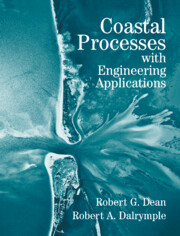Book contents
- Frontmatter
- Contents
- Preface
- Acknowledgments
- PART ONE INTRODUCTION TO COASTAL PROCESSES
- PART TWO HYDRODYNAMICS OF THE COASTAL ZONE
- PART THREE COASTAL RESPONSE
- 6 Field Measurement Techniques and Analysis
- 7 Equilibrium Beach Profiles
- 8 Sediment Transport
- 9 Miscellaneous Coastal Features
- 10 Modeling of Beaches and Shorelines
- PART FOUR SHORELINE MODIFICATION AND ANALYSIS
- Author Index
- Subject Index
10 - Modeling of Beaches and Shorelines
Published online by Cambridge University Press: 29 May 2010
- Frontmatter
- Contents
- Preface
- Acknowledgments
- PART ONE INTRODUCTION TO COASTAL PROCESSES
- PART TWO HYDRODYNAMICS OF THE COASTAL ZONE
- PART THREE COASTAL RESPONSE
- 6 Field Measurement Techniques and Analysis
- 7 Equilibrium Beach Profiles
- 8 Sediment Transport
- 9 Miscellaneous Coastal Features
- 10 Modeling of Beaches and Shorelines
- PART FOUR SHORELINE MODIFICATION AND ANALYSIS
- Author Index
- Subject Index
Summary
SUPERTANK may conjure up in your mind the title of a grade B movie but actually refers to one of the largest cooperative physical model studies ever carried out in coastal engineering. It was organized by the U.S. Army Corps of Engineers for the purpose of determining storm-induced erosion effects on coastlines in a wave tank large enough that modeling scale effects were not important.
The 8-week experiment, involving investigators from numerous universities, the Corps, and other institutions began in July 1991 in the O.H. Hinsdale Wave Research Laboratory at Oregon State University. The tank is 104 m long, 3.7m wide, and 4.6 m deep with a hydraulic hinged wave paddle at one end capable of generating random or monochromatic waves up to 1.5 m and absorbing reflected waves. A sand beach of 0.22 mm diameter was constructed over 76 m of the tank, utilizing approximately 1700 metric tons of beach sand trucked in from the Oregon coast.
The instrumentation in the tank included wave gages, current meters, pressure gauges, video cameras, and sediment concentration gauges to measure the hydrodynamics, and beach and dune response. More details about the experiments are given in Kraus and Smith (1994) and Smith and Kraus (1995).
INTRODUCTION
A major goal of coastal engineering is to develop models for the reliable prediction of short- and long-term nearshore evolution. Ideally, these models, with appropriate wave and sediment information, would allow prediction of the behavior of the shoreline and the offshore bathymetry over some given period of time.
- Type
- Chapter
- Information
- Coastal Processes with Engineering Applications , pp. 301 - 340Publisher: Cambridge University PressPrint publication year: 2001



